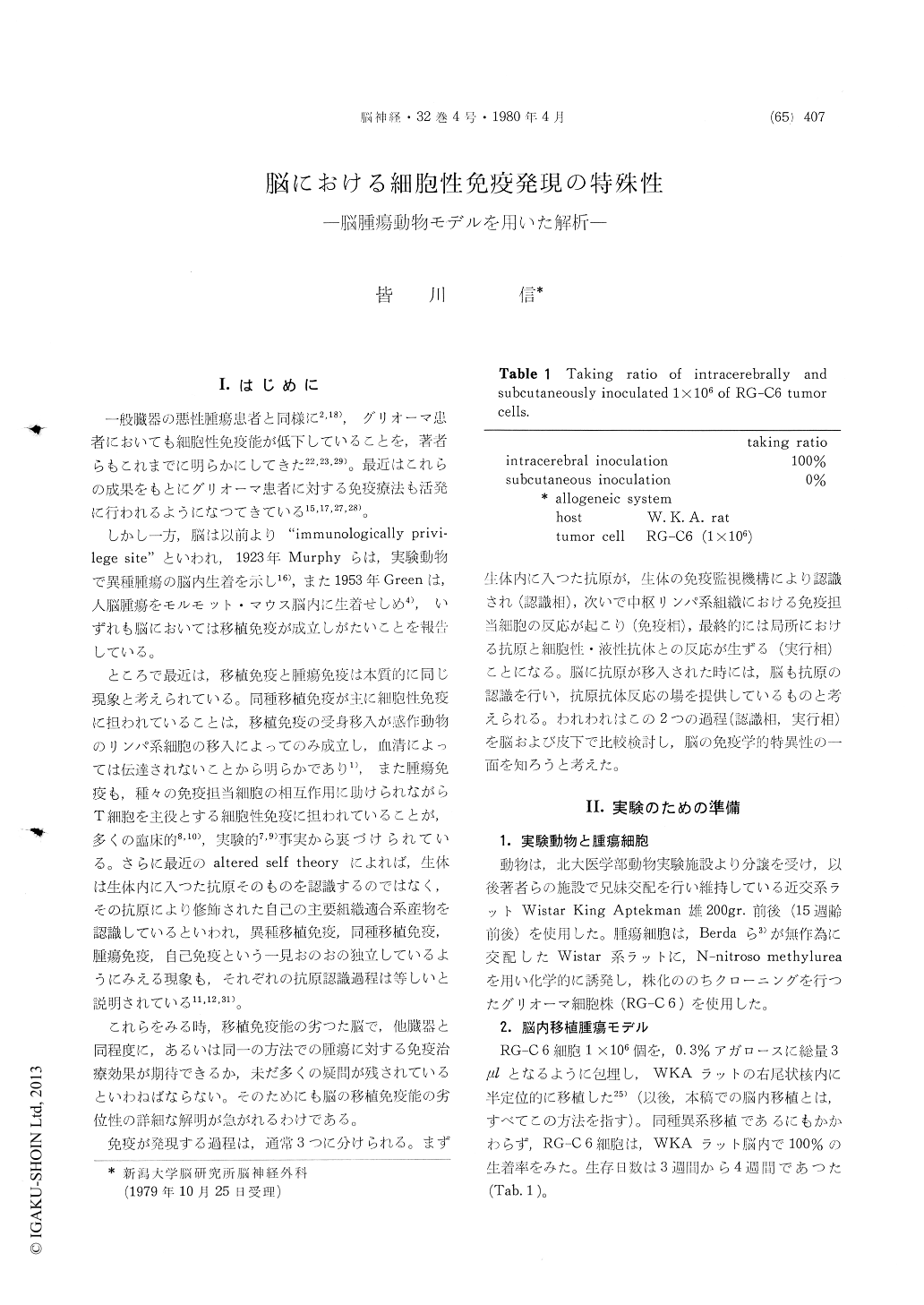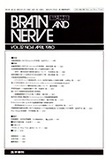Japanese
English
- 有料閲覧
- Abstract 文献概要
- 1ページ目 Look Inside
I.はじめに
一般臓器の悪性腫瘍患者と同様に2,18),グリオーマ患者においても細胞性免疫能が低下していることを,著者らもこれまでに明らかにしてきた22,23,29)。最近はこれらの成果をもとにグリオーマ患者に対する免疫療法も活発に行われるようになつてきている15,17,27,28)。
しかし一方,脳は以前より"immunologically privi—lege site"といわれ,1923年Murphyらは,実験動物で異種腫瘍の脳内生着を示し16),また1953年Greenは,人脳腫瘍をモルモツト・マウス脳内に生着せしめ4),いずれも脳においては移植免疫が成立しがたいことを報告している。
As is generally known, the brain is immunologi-cally a weak site. Some brain tumors develop easily in the brain, but develop with difficulty in the subcutaneous tissue of a allogeneic hosts. For example, intracerebrally inoculating 1×106 of RG-C6 glioma cells to allogeneic WKA rats, the inci-dence of take is about 100%. On the other hand, subcutaneously inoculating 1×106 of RG-C 6 cells, they are rejected promptly and there is no tumor growth. In order to get 100% of tumor take, it is necessary to inoculate 10 times of that number into the brain. In this condition, the subcutaneous tumor increases in size in about 8 days post-implant, and then involuted. The tumor disappeares at the 17th day post-implant. This characteristic may be attributed to the lack of cellular defense mechanism in the brain.
Referring to this problem, we studied the process of transplantation immunity and its collapse fol-lowing upon the tumor growth through our ex-perimental system as above mentioned, and analyzed the details of"immunological privilege"of the brain.
1) WKA rats which had been treated in advance with the subcutaneous inoculation of MMC-inac-tivated 1×106 of RG-C6 tumor cells acquired the resistance against the subcutaneous challenge of the fresh RG-C 6 cells. Nevertheless, the rats which had been treated in advance with the intra-cerebral inoculation of inactivated 1×106 of RG-C 6 cells had no resistance against the subcutaneous challenge. Then 1×107 of subcutaneously inocu-lated RG-C6 cells showed the usual growth and involution in the absence of the second set phe-nomenon. Accordingly it was surmised that the brain was immunologically a weak site for the functioning of the recognizing phase on immuno-logically a weak site for the functioning of the recognizing phase on immunological response.
2) The rats, in which the subcutaneously inocu-lated RG-C6 gliomas were at the terminal stage of spontaneous involution, acquired a resistance against the challenge of the tumor cells. The resistance originated from the immunological re-cognition of subcutaneously inoculated tumor cells, and it was manifested not only in the systemic subcutaneous tissue but in the distant brain. As the result, intracerebrally inoculated 1×106 of RG-C 6 glioma cells were completely rejected. This showed that the brain could offer the site for the functioning of the effector phase on immunological responses.
3) In order to induce the systemic specific resist-ance, we inoculated subcutaneously 1×107 of RG-C6 cells to the rats in which RG-C6 cells had been inoculated intracerebrally in advance. The rats could be divided into three types (Types 1, 2 & 3) according to each tumor growth. In the rats, whose original intracerebral tumors were small, subcutaneously challenged tumors involuted. And then those original intracerebral tumors also in-voluted (Type 1). In the rats, whose original in-tracerebral tumors were large, subcutaneously challenged tumors grew successively. Then those original intracerebral tumors also grow successively (Type 3). In the rats, whose sizes of original in-tracerebral tumors were between those of Type 1 and Type 3, subcutaneously challenged tumors involuted. Then those original intracerebral tumors grow successively (Type 2). As to Type 1, it was surmized that the functioning of the effector phase induced by recognition of subcutaneously chal-lenged tumor cells acted on rejecton of not only 1×106 of intracerebrally inoculated tumor cells but also relative small intracerebrally growing tumor. Nevertheless, as to Type 2, it was surmized that the brain was immunologically a weak site for the functioning of the effector phase compaired with subcutaneous tissue. As to Type 3, it was surmized that intracerebrally growing tumor caused the systemic immunoparalysis which permitted the subcutaneous growing of allogeneic tumor, and that immunoparalysis might be affected by the local brain damage.

Copyright © 1980, Igaku-Shoin Ltd. All rights reserved.


